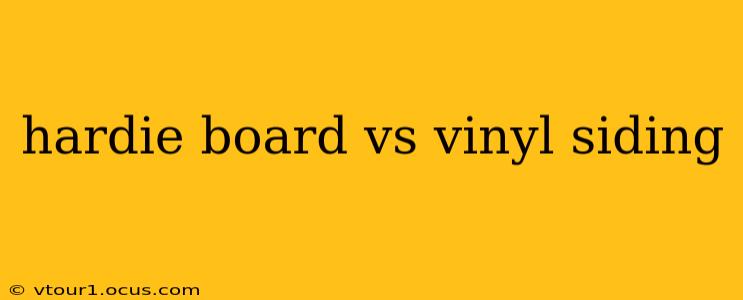Choosing the right siding for your home is a crucial decision impacting aesthetics, durability, and long-term costs. Two popular contenders consistently top the list: Hardie board (fiber cement) and vinyl siding. This comprehensive comparison will delve into the key differences, helping you make an informed choice for your specific needs and budget.
What is Hardie Board Siding?
Hardie board, also known as fiber cement siding, is a composite material made from cement, sand, and cellulose fibers. This robust blend results in siding exceptionally resistant to fire, insects, and rot. Its durability is a significant selling point, often boasting a lifespan exceeding 50 years with proper maintenance. Furthermore, Hardie board offers a wide variety of styles and colors, mimicking the look of wood, stone, or stucco.
What is Vinyl Siding?
Vinyl siding is a popular choice due to its affordability and ease of installation. Made from PVC (polyvinyl chloride), it's lightweight, relatively inexpensive, and requires minimal maintenance. Its low cost of ownership and simple installation are major draws for homeowners on a budget. Vinyl also comes in a range of colors and styles, though the variety may be slightly less extensive than Hardie board.
Hardie Board vs. Vinyl Siding: Key Differences
Here's a head-to-head comparison focusing on the critical aspects:
Durability and Lifespan
- Hardie Board: Exceptionally durable, resisting damage from impact, moisture, fire, and insects. A lifespan exceeding 50 years is common.
- Vinyl Siding: Less durable than Hardie board; prone to cracking, fading, and damage from impact. Lifespan typically ranges from 20-30 years.
Maintenance
- Hardie Board: Requires minimal maintenance, typically just occasional cleaning. Repairing minor damage is possible, but more complex repairs might need professional assistance.
- Vinyl Siding: Generally low maintenance, requiring only occasional cleaning. However, damage often necessitates replacement rather than repair.
Cost
- Hardie Board: More expensive upfront than vinyl siding due to higher material and installation costs.
- Vinyl Siding: Significantly more affordable initially, making it an attractive option for budget-conscious homeowners.
Appearance and Style
- Hardie Board: Offers a more realistic look and feel, mimicking various textures and materials like wood and stone. Provides a premium aesthetic.
- Vinyl Siding: Comes in a range of styles and colors, but the look may appear less authentic compared to Hardie board.
Environmental Impact
- Hardie Board: Manufacturing involves a higher carbon footprint compared to vinyl. However, its longer lifespan reduces the need for frequent replacements, mitigating some environmental concerns.
- Vinyl Siding: Its manufacturing process also has an environmental impact, and disposal can pose challenges due to its non-biodegradable nature. The longevity is significantly shorter compared to Hardie board.
Frequently Asked Questions (FAQs)
Is Hardie Board worth the extra cost?
The higher initial cost of Hardie board is often justified by its superior durability and longevity. While the upfront investment is greater, the reduced need for repairs and replacements over its lifetime can offset the initial expense. Consider it an investment in your home's long-term value.
How long does vinyl siding last?
Vinyl siding typically lasts between 20 and 30 years, depending on the quality of the material, installation, and exposure to the elements. Factors like intense sun exposure can accelerate degradation.
Which siding is better for hurricane-prone areas?
Hardie board's superior strength and resistance to high winds make it a better choice for hurricane-prone areas. Its resilience to impact damage is a significant advantage in severe weather conditions.
Can you paint Hardie Board siding?
Yes, Hardie board siding can be painted, offering even more customization options. However, using a paint specifically designed for fiber cement is crucial for optimal adhesion and longevity.
Is vinyl siding recyclable?
While some vinyl siding can be recycled, the process is not always widely available. Its disposal can pose environmental challenges due to its non-biodegradable nature.
Conclusion: Making the Right Choice
The best siding for your home depends on your individual priorities and budget. If durability, longevity, and a premium aesthetic are paramount, Hardie board is the superior choice, despite its higher cost. However, if budget is a primary concern and you're willing to accept a shorter lifespan and slightly lower durability, vinyl siding presents a viable alternative. Carefully weigh the pros and cons of each option to determine which best suits your needs and contributes to the long-term value of your property.
